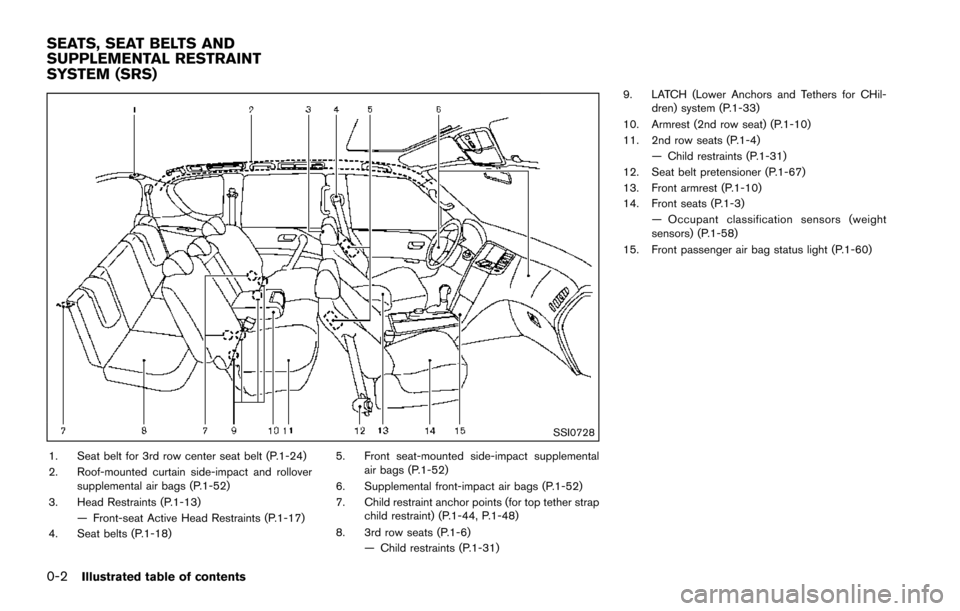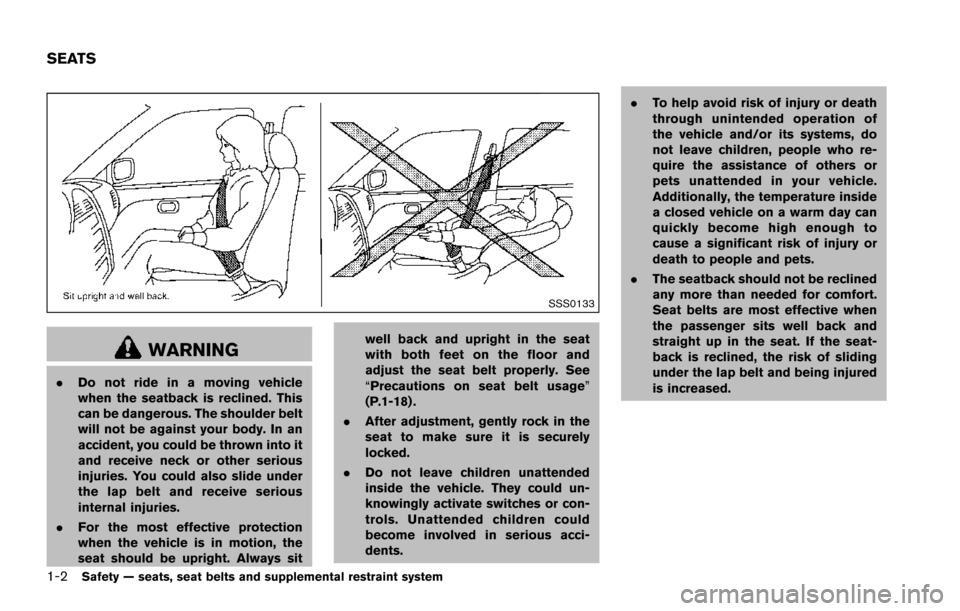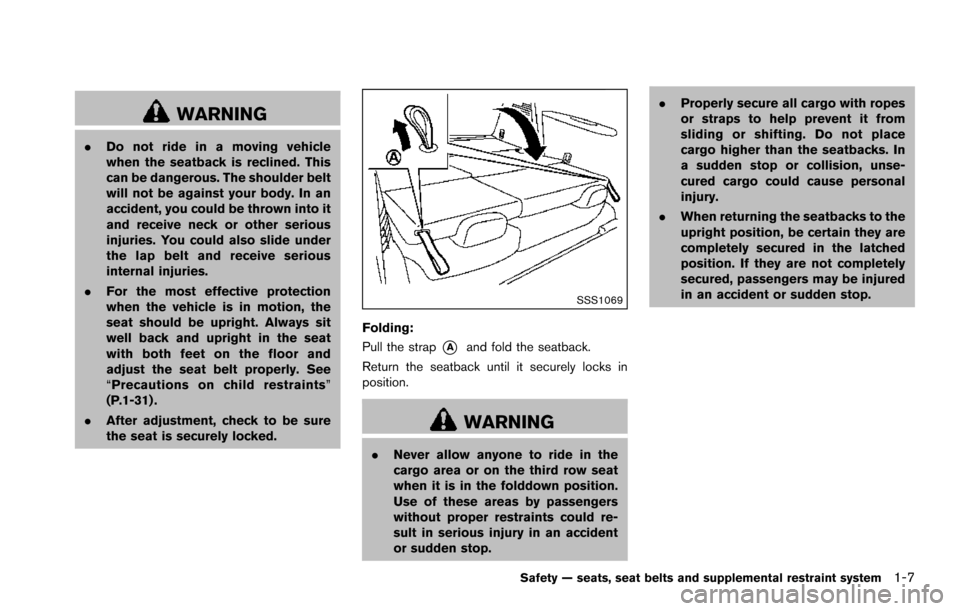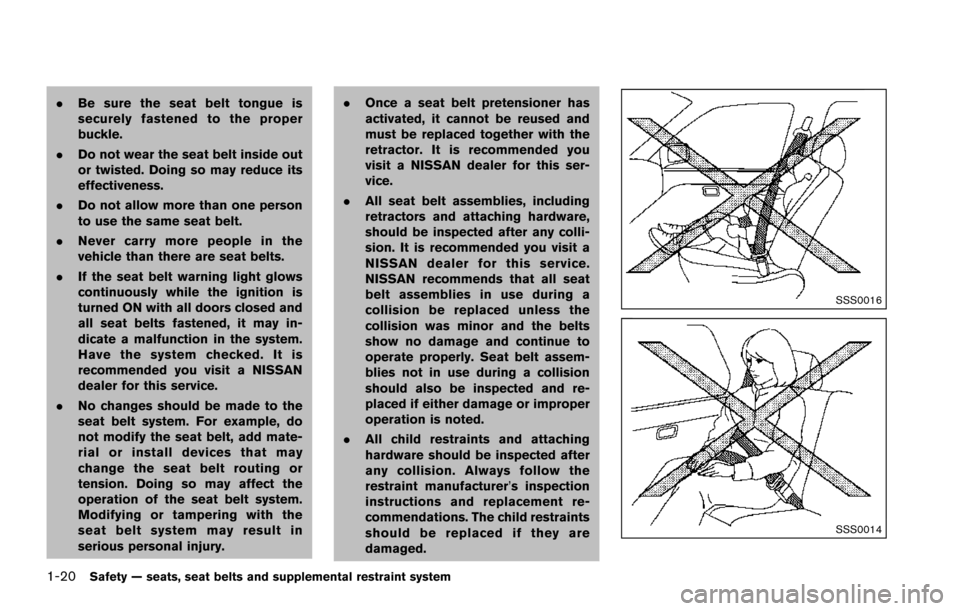2017 NISSAN ARMADA child restraint
[x] Cancel search: child restraintPage 9 of 614

0-2Illustrated table of contents
SSI0728
1. Seat belt for 3rd row center seat belt (P.1-24)
2. Roof-mounted curtain side-impact and rolloversupplemental air bags (P.1-52)
3. Head Restraints (P.1-13) — Front-seat Active Head Restraints (P.1-17)
4. Seat belts (P.1-18) 5. Front seat-mounted side-impact supplemental
air bags (P.1-52)
6. Supplemental front-impact air bags (P.1-52)
7. Child restraint anchor points (for top tether strap child restraint) (P.1-44, P.1-48)
8. 3rd row seats (P.1-6) — Child restraints (P.1-31) 9. LATCH (Lower Anchors and Tethers for CHil-
dren) system (P.1-33)
10. Armrest (2nd row seat) (P.1-10)
11. 2nd row seats (P.1-4) — Child restraints (P.1-31)
12. Seat belt pretensioner (P.1-67)
13. Front armrest (P.1-10)
14. Front seats (P.1-3) — Occupant classification sensors (weight
sensors) (P.1-58)
15. Front passenger air bag status light (P.1-60)
SEATS, SEAT BELTS AND
SUPPLEMENTAL RESTRAINT
SYSTEM (SRS)
Page 20 of 614

1 Safety — seats, seat belts and supplementalrestraint system
Seats ........................................................................\
.................... 1-2
Front seats ........................................................................\
.... 1-3
2nd row seats ...................................................................... 1-4
3rd row seats ....................................................................... 1-6
Armrest ........................................................................\
........ 1-10
Flexible seating ................................................................. 1-11
Head restraints/headrests .................................................... 1-13 Adjustable head restraint/headrest components ..... 1-14
Non-adjustable head
restraint/headrest components ..................................... 1-15
Remove ........................................................................\
....... 1-15
Install ........................................................................\
........... 1-16
Adjust ........................................................................\
.......... 1-16
Front-seat Active Head Restraint ................................. 1-17
Seat belts ........................................................................\
......... 1-18 Precautions on seat belt usage .................................... 1-18
Pregnant women .............................................................. 1-21
Injured persons ................................................................. 1-21
Three-point type seat belt .............................................. 1-21
Seat belt extenders .......................................................... 1-27
Seat belt maintenance .................................................... 1-27
Child safety ........................................................................\
...... 1-28 Infants ........................................................................\
.......... 1-29
Small children .................................................................... 1-29
Larger children .................................................................. 1-29 Child restraints ....................................................................... 1-31
Precautions on child restraints ................................... 1-31
Lower Anchors and Tethers for CHildren
System (LATCH) ............................................................ 1-33
Top tether strap child restraint ................................... 1-36
Rear-facing child restraint installation
using LATCH ................................................................... 1-36
Rear-facing child restraint installation using the
seat belts ........................................................................\
.. 1-38
Forward-facing child restraint installation
using LATCH ................................................................... 1-41
Forward-facing child restraint installation using the
seat belts ........................................................................\
.. 1-44
Booster seats .................................................................. 1-48
Supplemental restraint system ........................................... 1-52 Precautions on supplemental restraint system ....... 1-52
NISSAN Advanced Air Bag System
(front seats) ..................................................................... 1-58
Front seat-mounted side-impact supplemental
air bag and roof-mounted curtain side-impact and
rollover supplemental air bag systems ..................... 1-65
Seat belts with pretensioners (front seats) ............. 1-67
Supplemental air bag warning labels ....................... 1-68
Supplemental air bag warning light .......................... 1-68
Repair and replacement procedure .......................... 1-69
Page 21 of 614

1-2Safety — seats, seat belts and supplemental restraint system
SSS0133
WARNING
.Do not ride in a moving vehicle
when the seatback is reclined. This
can be dangerous. The shoulder belt
will not be against your body. In an
accident, you could be thrown into it
and receive neck or other serious
injuries. You could also slide under
the lap belt and receive serious
internal injuries.
. For the most effective protection
when the vehicle is in motion, the
seat should be upright. Always sit well back and upright in the seat
with both feet on the floor and
adjust the seat belt properly. See
“
Precautions on seat belt usage”
(P.1-18) .
. After adjustment, gently rock in the
seat to make sure it is securely
locked.
. Do not leave children unattended
inside the vehicle. They could un-
knowingly activate switches or con-
trols. Unattended children could
become involved in serious acci-
dents. .
To help avoid risk of injury or death
through unintended operation of
the vehicle and/or its systems, do
not leave children, people who re-
quire the assistance of others or
pets unattended in your vehicle.
Additionally, the temperature inside
a closed vehicle on a warm day can
quickly become high enough to
cause a significant risk of injury or
death to people and pets.
. The seatback should not be reclined
any more than needed for comfort.
Seat belts are most effective when
the passenger sits well back and
straight up in the seat. If the seat-
back is reclined, the risk of sliding
under the lap belt and being injured
is increased.
SEATS
Page 25 of 614

1-6Safety — seats, seat belts and supplemental restraint system
SSS1066
To enter the 3rd row seat, pull the lever*Aor
*Blocated on the 2nd row seat and fold the
seatback forward
*1at an angle over the seat
base. Then lift up the seat base and tip the 2nd
row seat forward
*2. This will release the back
of the seat so it may be tipped forward.
To exit the 3rd row seat, pull the lever
*Aor*B
and fold the seatback forward onto the seat
base. Then lift up on the seat base and tip it
forward.
SSS1068
3RD ROW SEATS
Manual seat adjustment (if so equipped)
Reclining:
Pull the strap
*Aand position the seatback at
the desired angle. Release the strap after
positioning the seat at the desired angle.
The reclining feature allows adjustment of the
seatback for occupants of different sizes to help
obtain proper seat belt fit. (See “Precautions on
child restraints” (P.1-31) .) The seatback may
also be reclined to allow occupants to rest when
the vehicle is parked.
Page 26 of 614

WARNING
.Do not ride in a moving vehicle
when the seatback is reclined. This
can be dangerous. The shoulder belt
will not be against your body. In an
accident, you could be thrown into it
and receive neck or other serious
injuries. You could also slide under
the lap belt and receive serious
internal injuries.
. For the most effective protection
when the vehicle is in motion, the
seat should be upright. Always sit
well back and upright in the seat
with both feet on the floor and
adjust the seat belt properly. See
“Precautions on child restraints”
(P.1-31) .
. After adjustment, check to be sure
the seat is securely locked.
SSS1069
Folding:
Pull the strap
*Aand fold the seatback.
Return the seatback until it securely locks in
position.
WARNING
. Never allow anyone to ride in the
cargo area or on the third row seat
when it is in the folddown position.
Use of these areas by passengers
without proper restraints could re-
sult in serious injury in an accident
or sudden stop. .
Properly secure all cargo with ropes
or straps to help prevent it from
sliding or shifting. Do not place
cargo higher than the seatbacks. In
a sudden stop or collision, unse-
cured cargo could cause personal
injury.
. When returning the seatbacks to the
upright position, be certain they are
completely secured in the latched
position. If they are not completely
secured, passengers may be injured
in an accident or sudden stop.
Safety — seats, seat belts and supplemental restraint system1-7
Page 38 of 614

SSS0136A
SSS0134A
WARNING
.Every person who drives or rides in
this vehicle should use a seat belt at
all times. Children should be prop-
erly restrained in the rear seat and,
if appropriate, in a child restraint.
. The seat belt should be properly
adjusted to a snug fit. Failure to do
so may reduce the effectiveness of
the entire restraint system and in-
crease the chance or severity of
injury in an accident. Serious injury
or death can occur if the seat belt is
not worn properly.
. Always route the shoulder belt over
your shoulder and across your
chest. Never put the belt behind
your back, under your arm or across
your neck. The belt should be away
from your face and neck, but not
falling off your shoulder.
. Position the lap belt as low and
snug as possible AROUND THE
HIPS, NOT THE WAIST. A lap belt
worn too high could increase the
risk of internal injuries in an acci-
dent.
Safety — seats, seat belts and supplemental restraint system1-19
Page 39 of 614

1-20Safety — seats, seat belts and supplemental restraint system
.Be sure the seat belt tongue is
securely fastened to the proper
buckle.
. Do not wear the seat belt inside out
or twisted. Doing so may reduce its
effectiveness.
. Do not allow more than one person
to use the same seat belt.
. Never carry more people in the
vehicle than there are seat belts.
. If the seat belt warning light glows
continuously while the ignition is
turned ON with all doors closed and
all seat belts fastened, it may in-
dicate a malfunction in the system.
Have the system checked. It is
recommended you visit a NISSAN
dealer for this service.
. No changes should be made to the
seat belt system. For example, do
not modify the seat belt, add mate-
rial or install devices that may
change the seat belt routing or
tension. Doing so may affect the
operation of the seat belt system.
Modifying or tampering with the
seat belt system may result in
serious personal injury. .
Once a seat belt pretensioner has
activated, it cannot be reused and
must be replaced together with the
retractor. It is recommended you
visit a NISSAN dealer for this ser-
vice.
. All seat belt assemblies, including
retractors and attaching hardware,
should be inspected after any colli-
sion. It is recommended you visit a
NISSAN dealer for this service.
NISSAN recommends that all seat
belt assemblies in use during a
collision be replaced unless the
collision was minor and the belts
show no damage and continue to
operate properly. Seat belt assem-
blies not in use during a collision
should also be inspected and re-
placed if either damage or improper
operation is noted.
. All child restraints and attaching
hardware should be inspected after
any collision. Always follow the
restraint manufacturer’s inspection
instructions and replacement re-
commendations. The child restraints
should be replaced if they are
damaged.
SSS0016
SSS0014
Page 40 of 614

PREGNANT WOMEN
NISSAN recommends that pregnant women use
seat belts. The seat belt should be worn snug,
and always position the lap belt as low as
possible around the hips, not the waist, and
place the shoulder belt over your shoulder and
across your chest. Never run the lap/shoulder
belt over your abdominal area. Contact your
doctor for specific recommendations.
INJURED PERSONS
NISSAN recommends that injured persons use
seat belts, depending on the injury. Check with
your doctor for specific recommendations.
THREE-POINT TYPE SEAT BELT
WARNING
.Every person who drives or rides in
this vehicle should use a seat belt at
all times.
. Do not ride in a moving vehicle
when the seatback is reclined. This
can be dangerous. The shoulder belt
will not be against your body. In an
accident, you could be thrown into it
and receive neck or other serious
injuries. You could also slide under
the lap belt and receive serious internal injuries.
. For the most effective protection
when the vehicle is in motion, the
seat should be upright. Always sit
well back and upright in the seat
with both feet on the floor and
adjust the seat belt properly.
JVR0183X
WARNING
Do not allow children to play with the
seat belts. Most seating positions are
equipped with Automatic Locking Re-
tractor (ALR) mode seat belts. If the
seat belt becomes wrapped around a
child’s neck with the ALR mode acti-
vated, the child can be seriously injured
or killed if the seat belt retracts and
becomes tight. This can occur even if
the vehicle is parked. Unbuckle the seat
belt to release the child. For the center
of the 3rd row bench seat, the connec-
Safety — seats, seat belts and supplemental restraint system1-21